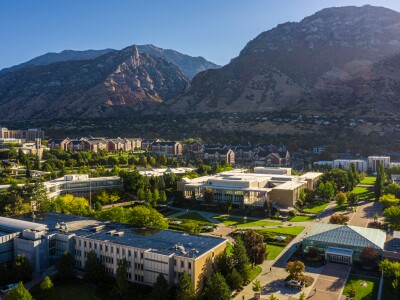"I never imagined I'd be tracking Antarctic icebergs in the middle of Utah," mused BYU junior Scheridan Vorwaller Cloward, reflecting on her three years' work for the Microwave Earth Remote Sensing (MERS) Laboratory.
Through the efforts of Cloward and her coworkers in the lab, BYU — despite being nestled in a landlocked state thousands of miles from the South Pole — has become one of the primary sources for iceberg tracking in the world.
Daily, the students provide valuable information about icebergs to the National Oceanic and Atmospheric Association (NOAA), the National Ice Center, and other international organizations. Iceberg data from the MERS Lab has been used to solve a wide range of problems, from helping scientists study whale sounds to helping cruise ships avoid collisions.
"Why is BYU in the middle of the desert involved in tracking icebergs? It's because we do remote sensing," said Dr. David Long, BYU professor of electrical and computer engineering.
The group takes their data from orbiting radars called scatterometers, which were originally designed to track wind vectors over the open ocean. Long, who helped develop the first scatterometers at NASA, pioneered a new application for the technology to track icebergs when he came to BYU.
"Tracking icebergs with a scatterometer is very unique to BYU," Cloward explained. "We use two scatterometers that are circling the earth, crossing over the poles, and sending down a radar signal. The way the radio waves interact with ice is very different from the way they interact with water. If we take that data and reimage it, we can make a picture that allows us to differentiate ice from water, so we can see landmasses and floating icebergs."
Iceberg images developed through scatterometry have distinct advantages over those developed from satellite cameras.
"It's very difficult to see Antarctica from space," Long said. "It's covered with clouds, it's dark. Radars can penetrate through the clouds, and they can see at night. Our radar data is almost as good as being there."
Over the years, BYU has processed radar data to assist the NOAA in recovering the location of "lost" icebergs and in keeping tabs on icebergs that pose risks to people or places.
For example, the lab recently made international news for tracking an iceberg that appeared to be on a collision course with South Georgia Island, where Ernest Shackleton and his crew famously finished their harrowing Antarctic expedition in 1916. Over 100 miles long, 50 miles wide, and several hundred meters thick — bigger than the island itself — iceberg A68A first broke from the Larsen Ice Shelf in 2017 and 2019 began moving rapidly into the South Atlantic.
"Now you have this huge mass of ice, and no one knows where it's going," said Cloward, who clocked the location of A68A twice daily for months. "That's where our research becomes really important."
If the bottom of the iceberg became stuck in the mud of South Georgia Island, it could decimate the island's wildlife, forcing penguins and seals to go around the iceberg to access their usual food sources and severely straining their energy levels. Fortunately, the iceberg broke into smaller pieces as it moved north into the warmer waters near the island.
Besides tracking potential iceberg collisions with landmasses and ships, the MERS Lab has seen some other "rather remarkable applications of the iceberg database," Long said.
Their records are providing a baseline for scientists who study climate change, showing how localized warming conditions are thinning some Antarctic ice shelves. Biologists study their database because icebergs release nutrients into the water as they melt, creating moving ecosystems. Additionally, since iceberg collisions cause "planet-size noises," Long said, scientists who study underwater sounds — such as those from whales or earthquakes — seek out iceberg location data to help them distinguish the source of different sounds.
Monitoring these magnificent icebergs has been a perspective-broadening experience for the students.
"I've appreciated the opportunities I've received at BYU to be a part of the MERS Lab, which has helped me learn that I'm connected to more than what I can see around me," Cloward said. "The world is our campus. That's really true."




